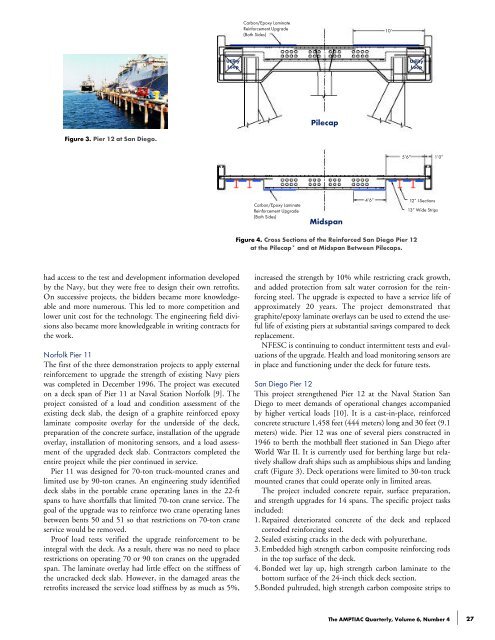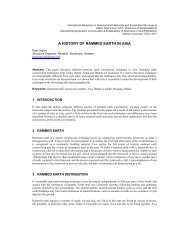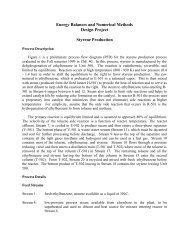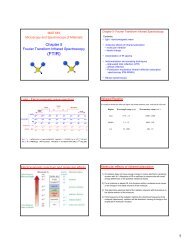Polymer Composite Retrofits Strength Concrete Structures - CEMR
Polymer Composite Retrofits Strength Concrete Structures - CEMR
Polymer Composite Retrofits Strength Concrete Structures - CEMR
Create successful ePaper yourself
Turn your PDF publications into a flip-book with our unique Google optimized e-Paper software.
Carbon/Epoxy Laminate<br />
Reinforcement Upgrade<br />
(Both Sides)<br />
10’<br />
Utility<br />
Loop<br />
Utility<br />
Loop<br />
Pilecap<br />
Figure 3. Pier 12 at San Diego.<br />
5’6” 1’0”<br />
Carbon/Epoxy Laminate<br />
Reinforcement Upgrade<br />
(Both Sides)<br />
Midspan<br />
4’6”<br />
12” I-Sections<br />
13” Wide Strips<br />
Figure 4. Cross Sections of the Reinforced San Diego Pier 12<br />
at the Pilecap* and at Midspan Between Pilecaps.<br />
had access to the test and development information developed<br />
by the Navy, but they were free to design their own retrofits.<br />
On successive projects, the bidders became more knowledgeable<br />
and more numerous. This led to more competition and<br />
lower unit cost for the technology. The engineering field divisions<br />
also became more knowledgeable in writing contracts for<br />
the work.<br />
Norfolk Pier 11<br />
The first of the three demonstration projects to apply external<br />
reinforcement to upgrade the strength of existing Navy piers<br />
was completed in December 1996. The project was executed<br />
on a deck span of Pier 11 at Naval Station Norfolk [9]. The<br />
project consisted of a load and condition assessment of the<br />
existing deck slab, the design of a graphite reinforced epoxy<br />
laminate composite overlay for the underside of the deck,<br />
preparation of the concrete surface, installation of the upgrade<br />
overlay, installation of monitoring sensors, and a load assessment<br />
of the upgraded deck slab. Contractors completed the<br />
entire project while the pier continued in service.<br />
Pier 11 was designed for 70-ton truck-mounted cranes and<br />
limited use by 90-ton cranes. An engineering study identified<br />
deck slabs in the portable crane operating lanes in the 22-ft<br />
spans to have shortfalls that limited 70-ton crane service. The<br />
goal of the upgrade was to reinforce two crane operating lanes<br />
between bents 50 and 51 so that restrictions on 70-ton crane<br />
service would be removed.<br />
Proof load tests verified the upgrade reinforcement to be<br />
integral with the deck. As a result, there was no need to place<br />
restrictions on operating 70 or 90 ton cranes on the upgraded<br />
span. The laminate overlay had little effect on the stiffness of<br />
the uncracked deck slab. However, in the damaged areas the<br />
retrofits increased the service load stiffness by as much as 5%,<br />
increased the strength by 10% while restricting crack growth,<br />
and added protection from salt water corrosion for the reinforcing<br />
steel. The upgrade is expected to have a service life of<br />
a p p roximately 20 years. The project demonstrated that<br />
graphite/epoxy laminate overlays can be used to extend the useful<br />
life of existing piers at substantial savings compared to deck<br />
replacement.<br />
NFESC is continuing to conduct intermittent tests and evaluations<br />
of the upgrade. Health and load monitoring sensors are<br />
in place and functioning under the deck for future tests.<br />
San Diego Pier 12<br />
This project strengthened Pier 12 at the Naval Station San<br />
Diego to meet demands of operational changes accompanied<br />
by higher vertical loads [10]. It is a cast-in-place, reinforced<br />
concrete structure 1,458 feet (444 meters) long and 30 feet (9.1<br />
meters) wide. Pier 12 was one of several piers constructed in<br />
1946 to berth the mothball fleet stationed in San Diego after<br />
World War II. It is currently used for berthing large but relatively<br />
shallow draft ships such as amphibious ships and landing<br />
craft (Figure 3). Deck operations were limited to 30-ton truck<br />
mounted cranes that could operate only in limited areas.<br />
The project included concrete repair, surface preparation,<br />
and strength upgrades for 14 spans. The specific project tasks<br />
included:<br />
1. Repaired deteriorated concrete of the deck and replaced<br />
corroded reinforcing steel.<br />
2. Sealed existing cracks in the deck with polyurethane.<br />
3. Embedded high strength carbon composite reinforcing rods<br />
in the top surface of the deck.<br />
4. Bonded wet lay up, high strength carbon laminate to the<br />
bottom surface of the 24-inch thick deck section.<br />
5.Bonded pultruded, high strength carbon composite strips to<br />
The AMPTIAC Quarterly, Volume 6, Number 4 27

















